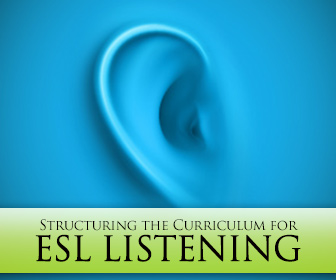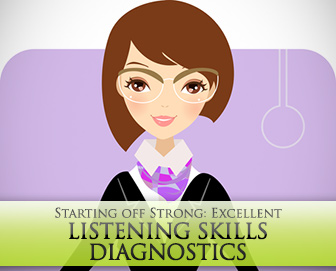What Do We Even Do All Term (or All Day)?: How to Structure the Curriculum for ESL Listening


Perhaps you’ve never taught ESL listening skills before and don’t quite know what to cover. Perhaps you’re waiting desperately for your copy of the textbook—maybe you’ll get some ideas there—or desperately searching the Internet. Those aren’t necessarily bad places to look, and some great ideas might be available. But the most important place to start is with your students and their needs. There are a number of skills to keep you busy all term in a listening class, and a good diagnostic will guide you toward which skills to teach.

Several skills should be tested on an ESL listening diagnostic: understanding directions, getting the main point of a lecture, and following the details of a story, for example, are all skills that students should become proficient in and should be on a diagnostic to determine how much proficiency students already have. In addition, anything on a standard syllabus for the class should be covered on the diagnostic: if understanding instructions, for example, is listed as a skill, that is something that should be taught during the semester and therefore should be assessed in the beginning to determine where students are going into the class. Any skill that will be taught in the class, in other words, should be first assessed, to determine students’ existing skill level and how much needs to be taught.

A good listening skills diagnostic should be thorough. It should assess, depending on student level and course demands, students’ ability to understand a conversation’s main points and details, to comprehend common questions and their appropriate responses, to note directions and instructions, to understand unfamiliar vocabulary using context, and to take basic notes on an academic lecture. So at the beginning ESL level, for example, it would be appropriate to test students’ ability to answer common personal questions and follow basic instructions while at a more advanced level students should be able to understand unfamiliar academic vocabulary in context and take notes on a simple college lecture.
A good listening skills diagnostic should also be simple while covering a number of skills students need in school and outside: the test should be no more than three pages, four at the most. The teacher, however, can keep the test simple while also being thorough, a matter of conciseness. One way to accomplish this is by testing more than one skill at a time. Having students answer questions about a short story, for example, tests their abilities at understanding main ideas and details as well as the ability to answer short questions (if the questions are given to them about the story in oral form) and to understand unfamiliar vocabulary in context.

Okay, I’ve collected the data; I’ve assessed my students’ class entry listening skills. Now what do I do with this information? This is a general problem in the contemporary world, as any user of the Internet will tell you: from the endless surveys people are asked to take, it would seem we’re very focused on collecting data. But one wonders on how much we actually use the data: does it get used to improve services or products, or does it just sit in some database? Having gone to the effort, on both the teacher’s and students’ parts, to collect this information on the diagnostic, of course it should be used. The question becomes “how?” How does the instructor analyze and use the data from the diagnostic in the classroom?
In reviewing students’ completed diagnostics, the instructor is likely to see repeated points of concerns: most students will have trouble understanding vocabulary in context, for example, as this is a very difficult skill, requiring a strong grasp of the language of instruction, and most students will also have trouble noting a precise set of directions in correct sequential order. These are then the skills that should be focused on over the course of the semester, rather than too much focus given to understanding main ideas of a story, which is a relatively easy skill to get, and if most students in class seem to have mastered it.
Once the data is collected and analyzed, the instructor can then develop a set of specific points of instruction: she knows that students have trouble with instructions and directions, so it would not be unreasonable to devote several weeks to instruction in taking directions as we do this so often in so many different forums, both face-to-face and on the phone, and in so many forms: driving directions, product assembly and use instructions, and so on. A particularly common and complex recent example of this form of listening is getting directions on how to get your computer working again, over the phone, from a very patient, but usually speaker of English as a second language, technical support person: a task that tries the listening skills of a native English speaker.
Again, any course has, or should have, a set of general course objectives. The diagnostic should be designed with these objectives in mind: e.g., if “listening for main ideas and details” is featured prominently on the course syllabus, then the instructor should certainly test for that. Once the assessment has been taken and analyzed, the instructor can then go back to the syllabus in deciding where, exactly, to fit these skills in the course of instruction: if students have a lot of trouble, for example, with understanding details related to a main idea, and this is a skill emphasized on the syllabus, then syllabus and diagnostic are in agreement, and nothing has to be adjusted or “tweaked.” However, if students have few problems in listening for details, while the syllabus seems to focus on it, the teacher can just devote a minimum amount of required time to the skill, perhaps engaging in some review of the skill, while meeting the demands of the course design and satisfying student need.
Finally, the larger or global issues should be considered first. If students have trouble with both understanding main ideas and comprehending specific academic vocabulary, the focus should be primarily on understanding main ideas and points as this is a skill that is needed in almost any listening situation. However, comprehending specific academic words applies to relatively few situations, mostly related to college lectures, so less attention should probably be paid to it, although some is still warranted, especially if students are planning to do further study in a university setting. And the two skills of course interrelate: understanding academic vocabulary will affect students’ ability to understand the main points of an academic lecture or discussion.
Designing, analyzing, and then using the data from a listening skills diagnostic is not easy. However, by carefully connecting the diagnostic to student level, the course syllabus, and the plan of instruction, the instructor can both design and use an excellent ESL listening skills diagnostic that will inform instruction for the semester.